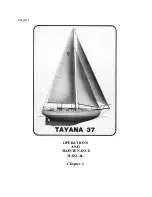
202 Islander
®
1.7
s
eCtIon
1 • s
aFety
Death or serious injury can result if you fail to observe
these safety rules:
• Anyone who controls the boat must have taken
a boating safety course and have been trained in
the proper operation of the boat.
• Always operate the boat at speeds that will not
put people or property in danger.
• Be constantly aware of conditions in all directions
when underway and before turning.
• Reduce speed, use a lookout to identify possible
hazards or difficulties, and turn on navigation
lights when:
- visibility is impaired;
- in rough water; and
- in congested waterways.
• Watch your wake. It can capsize a small boat or
damage moored boats or other property. You are
responsible for damage caused by your wake.
!
WARNING
Distribute passengers and gear as uniformly as
possible from front to rear and left to right.
The manufacturer's load rating is the maximum
allowed under calm conditions.
Reduce boat loading if weather, water or other
conditions are adverse.
!
WARNING
To maintain rated power, propellers should be free
of nicks, excessive pitting, and any distortions
that alter them from their original design. Badly
damaged propellers should be replaced, but those
that are chipped, bent, or merely out of shape can be
reconditioned by your marine dealer.
It is advisable
to carry an extra propeller aboard in case you
damage the one in use.
11. s
TabiliTY
Your boat was manufactured to specific stability
and flotation standards for the capacity shown
on the certification plate. Any increase from the
recommended load capacities will put your boat in
jeopardy of capsizing, swamping and/or sinking.
In addition:
• stability may be substantially reduced if
equipment is added above the deck.
• Stability is substantially reduced by loose fluids
or weight within the hull. keep bilge area as dry
as possible.
12. M
ainTain
c
onTrol
On the water there are no marked traffic lanes, no
traffic signs or lights, and boats have no turn signals
or brakes. The boat operator must keep her or his
attention focused not only on what's ahead but
what's on the left, right and behind the boat.
Observe the safety rules listed below:
The operator must always be alert to approaching boats
(from the rear, right and left sides, as well as those
ahead). In addition, the operator must be on the lookout
for people in the water, partially submerged debris, and
other navigational hazards such as rocks, sand bars,
and dangerous currents, to name a few.
your passengers are relying on you to operate and
maneuver the boat safely so that they are not in danger
of going overboard. If you turn too quickly, increase or
decrease speed abruptly, your passengers are at risk of
being thrown overboard or thrown about the boat.
When visibility becomes impaired because of weather,
time of day or high bow angle you must slow down so
that you have sufficient time to react if an emergency
occurs. nearby boats face similar risks in avoiding a
collision with you.
DO NOT ATTEMPT TO BOAT IN
SEVERE WEATHER CONDITIONS
DEATH OR SERIOUS INJURY CAN OCCUR
GET TO SHORE BEFORE
THE WEATHER TURNS BAD
!
DANGER
Содержание 202 Islander
Страница 4: ...ii 202 Islander this page intentionally left blank ...
Страница 28: ...202 Islander 1 18 R Speed changes you TM This Page Intentionally Left Blank ...
Страница 51: ...202 Islander 5 4 Section 5 Fuel System this page intentionally left blank ...
Страница 57: ...202 Islander 6 6 Section 6 Electrical Systems R Speed changes you TM this page intentionally left blank ...
Страница 59: ...6 8 202 Islander R Speed changes you TM DC Wire Information FIG 6 8 1 ...
Страница 81: ...9 4 Section 9 Care Refinishing 202 Islander This Page Intentionally Left Blank ...
Страница 83: ...Index 202 Islander This Page Intentionally Left Blank ...
















































